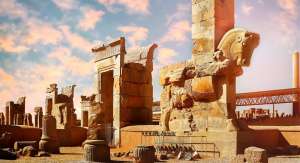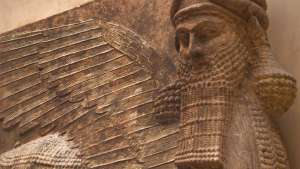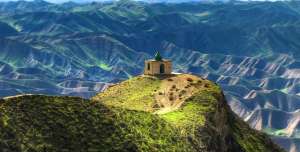The Rub' al Khali desert is the largest contiguous sand desert (erg) in the world, encompassing most of the southern third of the Arabian Peninsula. The desert covers some 650,000 km2 (250,000 sq mi) (the area of long. 44°30′−56°30′E, and lat. 16°30′−23°00′N) including parts of Saudi Arabia, Oman, the United Arab Emirates, and Yemen. It is part of the larger Arabian Desert.
The desert is 1,000 kilometres (620 mi) long, and 500 kilometres (310 mi) wide. Its surface elevation varies from 800 metres (2,600 ft) in the southwest to around sea level in the northeast. The terrain is covered with sand dunes with heights up to 250 metres (820 ft), interspersed with gravel and gypsum plains. The sand is of a reddish-orange color due to the presence of feldspar.
There are also brackish salt flats in some areas, such as the Umm al Samim area on the desert's eastern edge.
Ali Al-Naimi reports that the sand dunes don't drift. He goes on to say, "Sand blows off the surface, of course, but the essential shape of the dunes remains intact, probably due to the moisture leaching up into the base of the dunes from the surrounding sabkhas.":213
Lake beds
Along the middle length of the desert there are a number of raised, hardened areas of calcium carbonate, gypsum, marl, or clay that were once the site of shallow lakes. These lakes existed during periods from 6,000 to 5,000 years ago and 3,000 to 2,000 years ago. The lakes are thought to have formed as a result of "cataclysmic rainfall" similar to present-day monsoon rains and most probably lasted for only a few years. However, lakes in the Mundafen area in the southwest of the Rub' al Khali show evidence of lasting longer, up to 800 years, due to increased runoff from the Tuwaiq Escarpment.

Evidence suggests that the lakes were home to a variety of flora and fauna. Fossil remains indicate the presence of several animal species, such as hippopotamus, water buffalo, and long-horned cattle. The lakes also contained small snails, ostracods, and when conditions were suitable, freshwater clams. Deposits of calcium carbonate and opal phytoliths indicate the presence of plants and algae. There is also evidence of human activity dating from 3,000 to 2,000 years ago, including chipped flint tools, but no actual human remains have been found.
Climate
The region is classified as "hyper-arid", with annual precipitation generally less than 35 millimetres (1.4 in), and daily mean relative humidity of about 52% in January and 15% in June-July. Daily maximum temperatures average 47 °C (117 °F) in July and August, reaching peaks of 51 °C (124 °F). The daily minimum average is 12 °C (54 °F) in January and February, although frosts have been recorded. Daily extremes of temperature are considerable.
Biodiversity
Fauna includes arachnids (e.g. scorpions) and rodents, while plants live throughout the Empty Quarter. As an ecoregion, the Rub' al Khali falls within the Arabian Desert and East Saharo-Arabian xeric shrublands. The Asiatic cheetahs, once widespread in Saudi Arabia, are regionally extinct from the desert.







